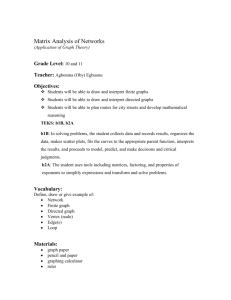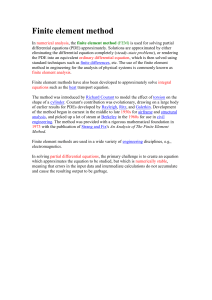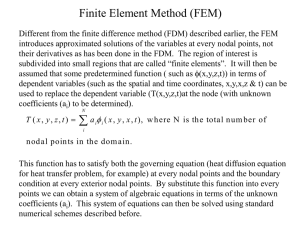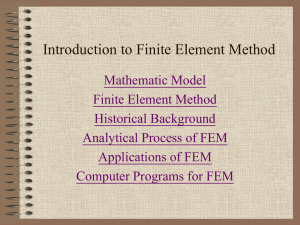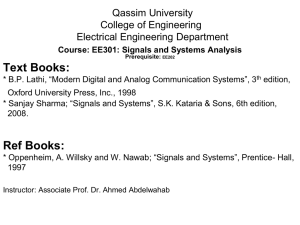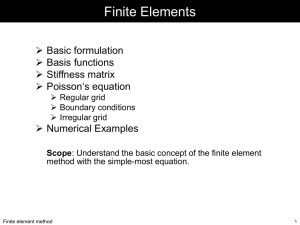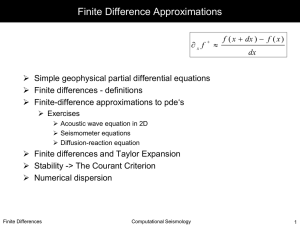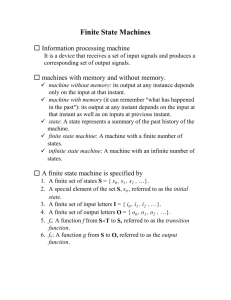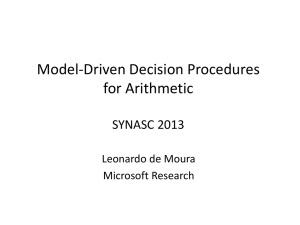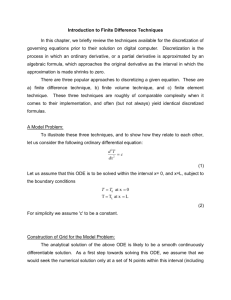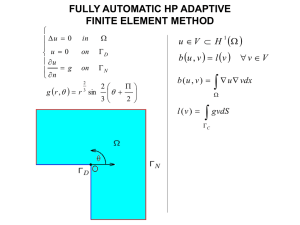Scope
advertisement
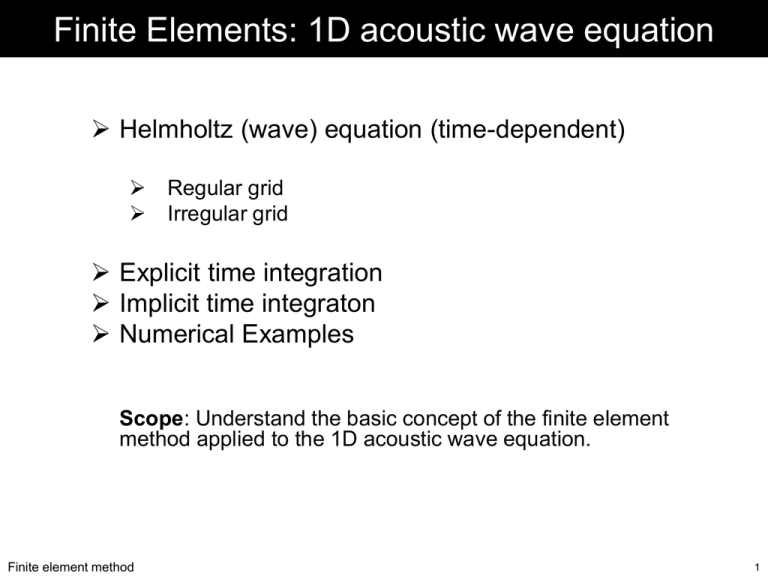
Finite Elements: 1D acoustic wave equation Helmholtz (wave) equation (time-dependent) Regular grid Irregular grid Explicit time integration Implicit time integraton Numerical Examples Scope: Understand the basic concept of the finite element method applied to the 1D acoustic wave equation. Finite element method 1 Acoustic wave equation in 1D How do we solve a time-dependent problem such as the acoustic wave equation? t2u v2u f where v is the wave speed. using the same ideas as before we multiply this equation with an arbitrary function and integrate over the whole domain, e.g. [0,1], and after partial integration 1 1 1 0 0 0 2 2 u dx v t j u j dx f j dx .. we now introduce an approximation for u using our previous basis functions... Finite element method 2 Weak form of wave equation N u u~ ci (t ) i ( x) i 1 note that now our coefficients are time-dependent! ... and ... N t2u t2u~ t2 ci (t ) i ( x) i 1 together we obtain 1 1 1 2 2 c dx v t i i j ci i j dx f j 0 i i 0 0 which we can write as ... Finite element method 3 Time extrapolation 1 1 1 2 2 c dx v t i i j ci i j dx f j 0 i i 0 0 M A mass matrix b stiffness matrix ... in Matrix form ... M T c v 2 AT c g ... remember the coefficients c correspond to the actual values of u at the grid points for the right choice of basis functions ... How can we solve this time-dependent problem? Finite element method 4 Time extrapolation M T c v 2 AT c g ... let us use a finite-difference approximation for the time derivative ... ck 1 2c ck 1 2 T M v A ck g 2 dt T ... leading to the solution at time tk+1: ck 1 (M T )1 ( g v2 AT ck ) dt2 2ck ck 1 we already know how to calculate the matrix A but how can we calculate matrix M? Finite element method 5 Mass matrix 1 1 1 2 2 c dx v t i i j ci i j dx f j 0 i i 0 0 ... let’s recall the definition of our basis functions ... 1 M ij i j dx 0 i=1 + 2 + 3 + h1 h2 Finite element method 4 + h3 x ~ h 1 i 1 ~ x ~ i ( x ) 1 hi 0 5 6 7 + + + h4 h5 h6 for hi 1 ~ x 0 for 0~ x hi ,~ x x xi elsewhere ... let us calculate some element of M ... 6 Mass matrix – some elements Diagonal elements: Mii, i=2,n-1 1 hi 1 0 0 M ii i i dx 2 hi 1 hi 3 3 i=1 + 2 + 3 + h1 h2 4 + h3 2 x x dx 1 dx hi hi 1 0 hi for hi 1 ~ x 0 for 0~ x hi elsewhere ji 5 6 7 + + + h4 h5 h6 xi hi-1 Finite element method x ~ h 1 i 1 ~ x i ( ~x ) 1 hi 0 hi 7 Matrix assembly Mij Aij % assemble matrix Mij % assemble matrix Aij M=zeros(nx); A=zeros(nx); for i=2:nx-1, for i=2:nx-1, for j=2:nx-1, for j=2:nx-1, if i==j, if i==j, M(i,j)=h(i-1)/3+h(i)/3; A(i,j)=1/h(i-1)+1/h(i); elseif j==i+1 elseif i==j+1 M(i,j)=h(i)/6; A(i,j)=-1/h(i-1); elseif j==i-1 elseif i+1==j M(i,j)=h(i)/6; A(i,j)=-1/h(i); else else M(i,j)=0; A(i,j)=0; end end end end Finite element method end end 8 Numerical example Finite element method 9 Implicit time integration M T c v 2 AT c g ... let us use an implicit finite-difference approximation for the time derivative ... ck 1 2c ck 1 2 T M v A ck 1 g 2 dt T ... leading to the solution at time tk+1: 2 2 gdt T 1 ck 1 M v dt A T 2 M T 2c ck 1 How do the numerical solutions compare? Finite element method 10 Summary The time-dependent problem (wave equation) leads to the introduction of the mass matrix. The numerical solution requires the inversion of a system matrix (it may be sparse). Both explicit or implicit formulations of the time-dependent part are possible. Finite element method 11


